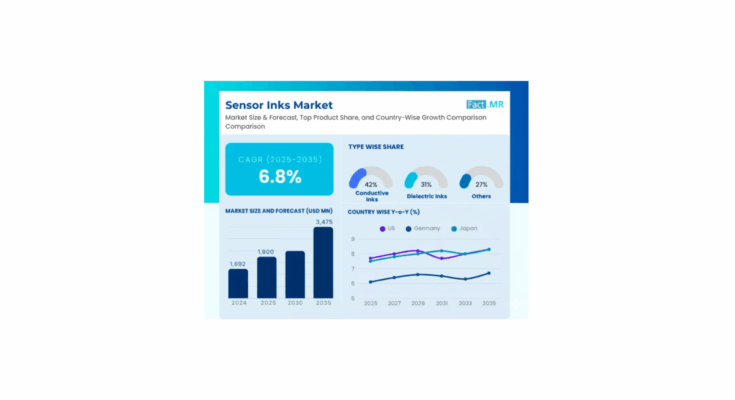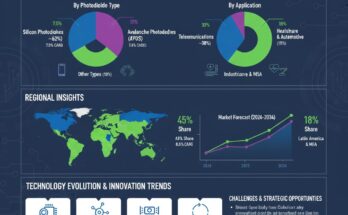The global sensor inks market is projected to reach USD 3,475 million by 2035, up from USD 1,692 million in 2024, expanding at a robust CAGR of 6.8% during the forecast period (2025–2035). The market’s growth is fueled by increasing demand for flexible, low-cost sensor inks in wearable health monitors, automotive pressure sensors, and intelligent packaging applications.
Sensor inks, known for their compatibility with roll-to-roll printing, high conductivity, and stability, are becoming critical enablers for real-time diagnostics, condition monitoring, and embedded electronics. These technologies are driving the next generation of flexible and scalable electronic solutions.
Market Drivers: Innovation in Wearables and Industry 4.0
The adoption of sensor inks is rising sharply due to the increasing demand for low-cost, high-performance sensing technologies. In medical wearable devices, inks must adhere to skin, survive transport, and deliver accurate feedback. Silver nanoparticles and carbon-based inks meet these requirements, providing biocompatible substrates and enabling rapid, high-speed printing.
Industrial automation represents another key driver. Printed temperature, pressure, and strain sensors are being embedded into factory equipment to enable predictive maintenance. Sensor inks’ mechanical flexibility and durability make them suitable for vibration-sensitive or thermally variable environments, aligning with Industry 4.0 requirements.
The changing dynamics of retail and logistics are also boosting demand. Printed and electronic labels allow real-time monitoring of temperature, humidity, and food freshness. Sensor inks, designed to dry quickly and maintain long shelf-life, are increasingly used in smart labeling and supply chain intelligence initiatives.
Regional Market Trends
North America leads commercialization efforts, driven primarily by healthcare applications. The United States integrates sensor inks into medical patches, glucose meters, and remote patient monitoring systems. Venture capital, research complexes, and early adopter OEMs further reinforce the region’s leadership.
Europe focuses on eco-compliance and automotive electronics. Germany, in particular, is developing printed sensor units for intelligent interiors and electric vehicle components. EU programs such as Horizon Europe continue to support the development of sustainable and stretchable sensor materials.
The Asia Pacific region is emerging as the fastest-growing market, led by Japan and South Korea. Japan invests in robotic health aids and ambient assisted living systems, while South Korean companies produce flexible sensor arrays for smartphones, displays, and automotive applications. China is leveraging mass production capabilities and government-backed electronics programs to fuel expansion.
Challenges and Market Restraints
Despite strong growth, challenges persist. Variability in ink performance across substrates such as PET, TPU, and biodegradable films can reduce device precision and lifetime. Regulatory and toxicological compliance remains complex, particularly with metallic nanoparticles and chemical binders, delaying product rollouts and increasing costs.
Country-Specific Insights
-
United States: Leads biomedical integration and wearable electronics. Silver-based inks suitable for skin contact and diagnostic disposables are rapidly gaining traction. Strong collaboration with healthcare OEMs and supply chain integrators supports innovation and market stability.
-
Japan: Focuses on precision-engineered sensor inks for robotics, healthcare, and automotive applications. Motion tracking, physical therapy, and ambient assisted living platforms benefit from high-reliability, multi-cycle inks.
-
Germany: Emphasizes industrial automation and automotive sensor integration. Smart infrastructure and logistics solutions increasingly leverage durable, high-performance sensor inks, while intra-European and Middle East exports highlight technological leadership.
Category-Wise Market Insights
Conductive inks dominate the market due to their essential role in flexible electronics, including printed circuit boards, RFID tags, and flexible sensors. Carbon- and silver-based inks lead in performance, offering high conductivity, flexibility, and reliability across healthcare, automotive, and consumer electronics sectors.
Wearable electronics represent the fastest-growing application segment. Flexible, stretchable, and skin-friendly sensor inks enable real-time monitoring of health, fitness, and biometric data. Regulatory emphasis on patient safety and efficacy further supports growth in this domain, particularly in the U.S., Germany, and Japan.
Competitive Landscape and Recent Developments
Key market players include DuPont, Henkel AG & Co. KGaA, Sun Chemical Corporation, Heraeus Holding GmbH, Poly-Ink, NovaCentrix, Creative Materials Inc., Johnson Matthey, Vorbeck Materials, Electroninks, Applied Ink Solutions, and InkTec Co., Ltd. Competition revolves around print compatibility, electrical performance, and durability. Hybrid inks incorporating silver, carbon, and graphene are gaining traction.
Recent innovations include:
-
Creative Materials Inc. (June 2025): Launched 126-40 series conductive epoxies offering fine-line precision, solvent resistance, and low-temperature curing for touchscreen bus bars and membrane switches.
-
Veolia PlastiLoop (June 2025): Introduced chemical recycling initiatives to integrate recycled resins into consumer products, supporting sustainable sensor ink applications.
Methodology and Industry Tracking
Fact.MR’s 2025 sensor inks market report compiles insights from 1,200 stakeholders across 12 countries. Data was collected from June 2024 to May 2025, targeting performance indicators such as conductivity, drying time, adhesion, substrate compatibility, and sintering requirements. Validation included over 95 sources, including technical reports, peer-reviewed research, government filings, and product specifications.
Analytical tools, including multivariate regression and scenario modeling, were applied to deliver robust, actionable insights on market sizing, growth opportunities, pricing, and end-use evolution. Continuous monitoring since 2018 ensures strategic guidance for firms seeking competitive advantage and sustainable growth.
Segmentation Overview
-
By Type: Conductive Inks, Dielectric Inks, Piezoelectric Inks, Thermochromic Inks
-
By Technology: Screen Printing, Inkjet Printing, Flexographic Printing
-
By Application: Wearable Electronics, Automotive Sensors, Medical Devices, Industrial IoT, Smart Packaging
-
By End-User Industry: Electronics & Semiconductors, Healthcare, Automotive, Aerospace & Defense, Consumer Goods
-
By Region: North America, Latin America, Western Europe, Eastern Europe, East Asia, South Asia & Pacific, Middle East & Africa
Conclusion
The sensor inks market is entering a high-growth phase, driven by flexible electronics, wearable health devices, automotive innovations, and smart packaging. With advancements in conductive, biocompatible, and hybrid inks, industry leaders have unprecedented opportunities to innovate and expand globally, while meeting evolving consumer and regulatory demands.
Browse Full Report : https://www.factmr.com/report/sensor-inks-market


